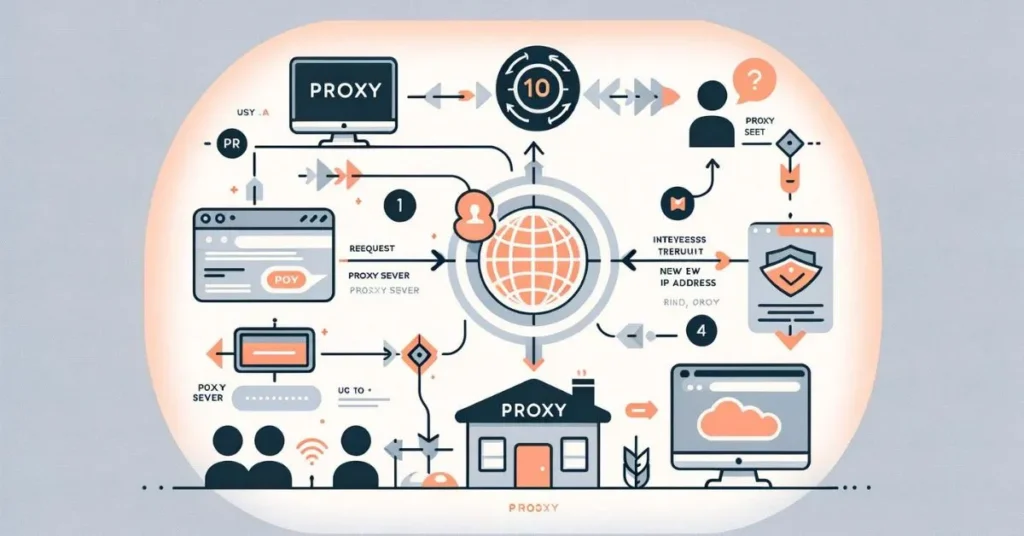Proxies are one of the most innovative online security and privacy technologies of the past decade. The many ways to use them and the variety of different types might confuse those who are unacquainted with them. Here, we’ll cover the basics of proxies, focusing on their types and usage.
Contents
Types of proxies
Proxies are devices, usually servers or PCs, that act as intermediaries between you and the internet. They are set up to route your network requests and send them as their own, hiding your original IP address and showing a different location to the target server.
The way they achieve this function enables them to be categorized into various types. The first thing most proxy users look for is the location. Make sure that it’s an advanced country with high-speed internet and it will have all the other types of proxies I list below.
By origin of IP address
The origin of the IP address might also differ depending on how the proxy device accesses the internet. There are three main types of proxies categorized this way.
Residential proxies use physical devices running on household connections verified by internet service providers (ISPs). Proxies residential is the best option for when you need the highest anonymity.
Datacenter proxies use powerful servers in commercial hubs with business-tier internet infrastructure. The IPs are created virtually and are unverified by residential ISPs, so they are very fast, but websites might notice you are using a proxy.
Mobile proxies ensure access to mobile websites and services by using mobile devices to act as intermediaries. They are a bit slower, and IP addresses are dynamic, but with the rise of 4G and 5G, mobile proxies are getting better each year.
By access options
All the above-mentioned types of proxies can be shared, semi-shared, and private (dedicated). Such distinction refers to how many users can access a proxy IP address concurrently.
Shared proxies are the cheapest, but the fluctuating number of users results in an unstable performance. Semi-shared proxies try to balance this by limiting user access but still sharing the proxy connection.
Private proxies are a premium type that provides exclusive and, in many cases, unlimited access to one customer. Such proxies can cost a lot of money, but the performance is definitely worth it with little disturbances or unexpected IP address bans created by others.
Common proxy usage scenarios
Some proxies are specifically marketed and tested for some use cases. Sneaker proxies, for example, are one of the most popular among such types. However, on a better look, these proxies are just like the rest, except that they are tested and selected to work best on a specific website.
Your usage scenarios might be unique – no one can know what pages you will visit and what software and hardware you are using. So, it makes more sense to talk about specific use cases and recommend fitting proxy types than discuss them as proxy types.
Bypassing geo-restrictions
Proxies are great for integrating into various software – operating systems, browsers, automation tools, etc. They allow you to change your location and target specific regions, cities, or even neighborhoods. Websites or online services limiting data availability based on visitors’ location will not restrict you.
Residential proxies are especially great for this scenario, as you won’t be transferring a lot of data but need the best possible IP legitimacy and location accuracy. Other might also work, but most websites tolerate residential proxies best.
Using proxies for bypassing geo-restrictions is easiest by entering proxy credentials into your browser settings. Mozilla Firefox works best for this purpose. Google Chrome will require you to install a proxy manager extension. If you want the most anonymity settings and tweaks, consider trying an anti-detect browser like Dolphin Anty.
Web scraping
The internet is full of useful data for businesses and individuals. But collecting data for market research, sales leads, price and trend monitoring, brand protection, machine learning, and other applications requires lots of time. In many cases, it’s simply not possible to acquire the needed data manually.
That’s where web scraping comes in. It’s the process of using automated software (called scraper bots or scrapers) to visit websites, index their content, and then extract what’s needed for the user. It takes only a couple of clicks, and then you only need to analyze the data.
Proxies solve the problem of IP bans and geo-restrictions while web scraping. Websites block scraping software, so you need access to multiple IP addresses. Most web scraping browser extensions or software, such as Parse Hub, require running proxy servers.
Datacenter proxies are the best option because of their speed and low cost. You will likely transfer a lot of data while web scraping and your IP addresses might get banned often.
Bulk purchasing
Whether it’s top-of-the-line sneakers, fastest graphic cards, or concert tickets, purchasing more than one might be problematic. The first issue is checking out your goods in time, for there is always someone faster than you. Automating this task with online bots solves it, but you risk getting your home IP address banned from the online shop.
Another issue is that some websites allow only one purchase per IP address regarding limited-availability goods. They solve both of these issues, providing you with a pool of IP addresses to shield your original IP address and bypass purchase restrictions.
Usually, such automation is performed with tools like Selenium, which allows users to perform online actions automatically. Mobile proxies are used most often for bulk purchasing tasks because many e-commerce websites nowadays mostly focus on mobile versions. However, such automation is used for many more things, and proxies are also necessary.
Wrapping up
In the end, proxies are a simple technology that enables one device to route the connection of the other, changing its IP address. The variety of types creates a lot of usage possibilities. Now, you should know enough of the basics to find use cases that will complement your projects.











